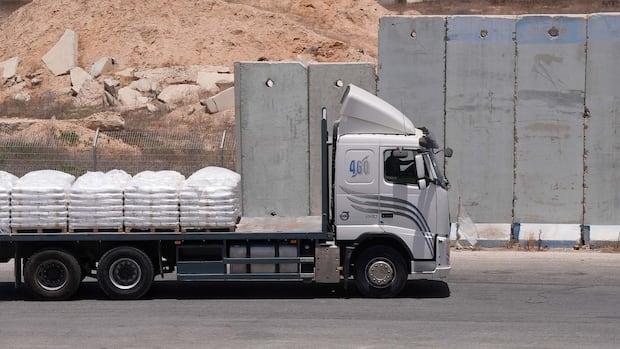Israeli forces may have repeatedly violated the laws of war and failed to distinguish between civilians and fighters in the Gaza conflict, the UN human rights office said on Wednesday.
Separately, the head of a UN inquiry accused the Israeli military of carrying out the “extermination” of Palestinians.
In a report on six Israeli attacks that caused many casualties and destroyed civilian infrastructure, the UN human rights office (OHCHR) said Israeli forces “may have systematically violated the principles of distinction, proportionality and precautions in attack.”
“The requirement to select means and methods of warfare that avoid or at the very least minimize to every extent civilian harm appears to have been consistently violated in Israel’s bombing campaign,” UN High Commissioner for Human Rights Volker Turk said.
Israel’s permanent mission to the United Nations in Geneva characterized the analysis as “factually, legally and methodologically flawed.”
“Since the OHCHR has, at best, a partial factual picture, any attempt to reach legal conclusions is inherently flawed,” the Israeli diplomatic mission said.
Refugee camp strikes analyzed
The UN rights office report released on Wednesday details six incidents that took place between Oct. 7 and Dec. 2, in which it was able to assess the kinds of weapons, the means and the methods used in these attacks. The incidents included those that struck camps for Palestinian refugees at Jabliya and Al Bureij.
“We felt that it was important to get this report out now, especially because in the case of some of these attacks, some eight months have passed, and we are yet to see credible and transparent investigations,” said Ravina Shamdasani, spokesperson for the UN human rights office.
She went on to say that in the absence of transparent investigations, there would be “a need for international action in this regard.”
In a separate meeting of the UN Human Rights Council in Geneva, the head of a UN Commission of Inquiry, Navi Pillay, said perpetrators of abuses in the conflict must be brought to account.
She repeated findings from a report published last week that both Hamas militants and Israel have committed war crimes, but said that Israel alone was responsible for the most serious abuses under international law known as “crimes against humanity.”
She said the scale of Palestinian civilian losses amounted to “extermination.”
WATCH l Conflicting accounts on why more food isn’t reaching Palestinians:
Israel has promised daily ‘tactical pauses’ along a stretch of the Gaza border to help with the flow of humanitarian aid. But not everyone is convinced the measure will be followed or actually help Palestinians who are struggling to survive the humanitarian crisis.
“We found that the immense numbers of civilian casualties in Gaza and widespread destruction of civilian objects and infrastructure were the inevitable result of an intentional strategy to cause maximum damage,” Pillay, a former UN High Commissioner for Human Rights, told the Geneva meeting.
Israel, which does not co-operate with the inquiry and alleges an anti-Israel bias, chose the mother of a hostage to speak on its behalf and criticized the report on the grounds that it did not give due attention to hostages taken by Hamas on Oct. 7.
“We can do better for them. The hostages need us,” Meirav Gonen, the mother of 23-year-old hostage Romi Gonen, said in a tearful appeal.
Israel’s air and ground offensive has killed more than 37,400 people in the Hamas-ruled Palestinian territory, according to health authorities in Gaza
Israel launched its assault after militants led by Hamas stormed across the border into southern Israel on Oct. 7, killing around 1,200 people, including several Canadian citizens. That total is according to Israeli government tallies, which also indicate that about 115 people are unaccounted for after 250 were taken hostage, with dozens of survivors repatriated while several others have been confirmed dead.
In Gaza on Wednesday, Israeli tanks backed by warplanes and drones advanced deeper into the western part of Rafah, killing eight people, according to residents and Palestinian medics.
Residents said the tanks moved into five neighbourhoods after midnight. Heavy shelling and gunfire hit the tents of displaced families in the Al-Mawasi area, further to the west of the coastal enclave, they said.
Medics and Hamas media said eight Palestinians were killed in Al-Mawasi and many families fled north in panic. They did not identify the fatalities and the Israeli military said it was looking into the report.
The Israeli military remained in control of the borderline between Rafah and Egypt. Footage circulated on social media showed the Rafah crossing, the only window for most of Gaza’s population with the outside world, was destroyed, buildings burned and Israeli tanks positioned there with the flag of Israel flying over some places.
READ | UN report on 6 war incidents in which Gaza citizens were killed:
Further north, Israel sent a column of tanks back into the Zeitoun neighbourhood in Gaza City and residents reported heavy fire from tanks and warplanes but also sounds of gun battles with Hamas-led fighters.
In another Gaza City suburb, Sheikh Radwan, an Israeli airstrike on a house killed four Palestinians, including a child, medics said.




